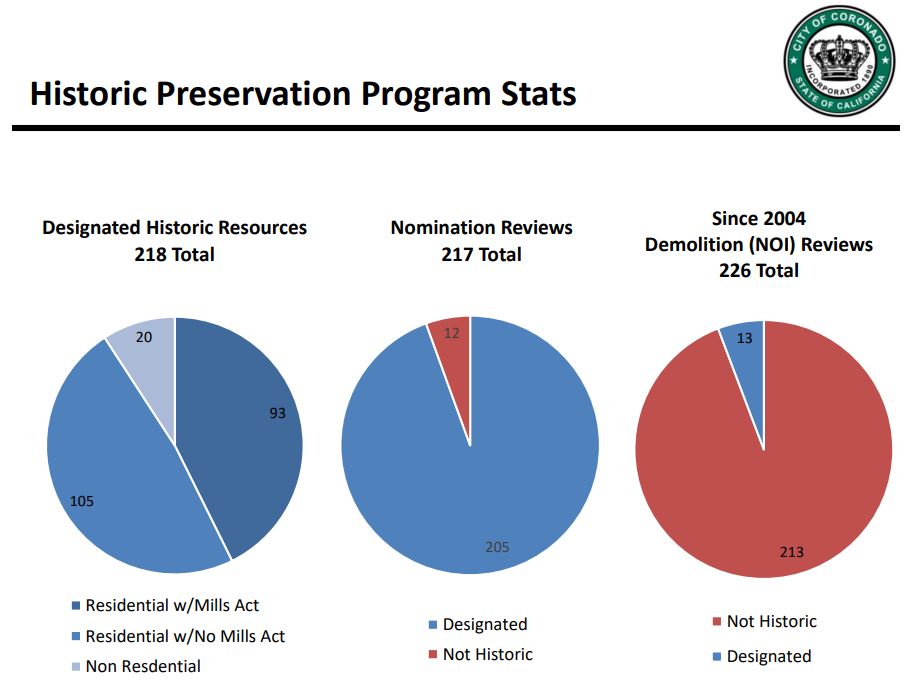 Councilmembers Carrie Downey and Mike Donovan are on a mission to make updates to Coronado’s Historic Preservation Program Process. About 30 people attended the public forum they hosted on Monday, May 22, to present their recommendations after having reviewed various aspects of the process. At the April 3rd City Council meeting, they volunteered to form a subcommittee to study this issue and they have been hard at work ever since, along with Tricia Olsen, Associate Planner for the city and staff liaison for the Historic Resource Commission.
Councilmembers Carrie Downey and Mike Donovan are on a mission to make updates to Coronado’s Historic Preservation Program Process. About 30 people attended the public forum they hosted on Monday, May 22, to present their recommendations after having reviewed various aspects of the process. At the April 3rd City Council meeting, they volunteered to form a subcommittee to study this issue and they have been hard at work ever since, along with Tricia Olsen, Associate Planner for the city and staff liaison for the Historic Resource Commission.
Since the Historic Preservation Program began in 2000, there have been 218 designated historic resources, including residential, with and without Mills Act designation, and non-residential properties. Since 2004, there have been 226 Notice of Intent (NOI) demolition reviews with only 13 of them historically designated. Olsen has recently created a map of all the historic homes which is linked on this page: www.coronado.ca.us/preservation.
The goal of this subcommittee is to develop recommendations for potential improvements to the program, including the application and appeal process, criteria for historic designation, fees, demolition requests, and Mills Act approach, with community input. Councilmember Downey said, “The City isn’t saying these concerns are all accurate, but we are trying to address the public’s concern.”
The current Historic Preservation Incentives include a reduction in fees, historic building code, and eligibility for Mills Act, condo conversion, and applying for exceptions to parking, setback, Floor Area Ratio (FAR) and height zoning standards.
Potential concerns to be addressed are the current uncertainly for residents and developers, the long and costly process, the mandated 75-year old house ruling, vague designation criteria and the necessity of having to meet two criteria, how to inform the public, and the lengthy Mills Act waiting list.
Their proposal includes conducting a professional Historic Home Survey, with an update every 10 years, and Historic Context Statement, which would develop a list of all eligible homes, reduce number of required criteria from two to one for qualification, which is what San Diego and many other cities do, survey list for public review and adoption by City Council. If houses are not on the list, then there would be no requirement for further historic review for demolition permits.
For the homes on the list, no action would be required unless the owner applies for historic designation or a demolition permit. For the review process, there would not be an application fee, but a third party review would be required, for which the city would potentially share the cost with the homeowner. The city would solicit bids for and select professional historic research contractors, and require an independent report with the Historic Resource Commission (HRC) review. They are estimating that the review would cost between $4,000 and $5,000 and would provide more objectivity to the evaluation process.
There are currently five historic designation criteria, the first being that the house is designated historic by the state, and the other four are applicable in Coronado’s program.
Criterion A covers if the house exemplifies special military, cultural, social, economic, political, aesthetic, engineering, or architectural elements. The Councilmembers review found that this needs more clarification, deleting architectural significance because it is covered in Criterion C.
Criterion B covers if a person or event significant in local, state or nation history was associated with the home. One of the questions asked is “Can you designate more than one home per significant person?”
Criterion C highlights the distinctive characteristics of an architectural style, which has not been substantially altered, but the recommendation is to delete “is valuable for the study, period, or method of construction.”
Criterion D denotes if a house is representative of notable works of a professional builder, designer, architect or landscape architect vs all of their works. The subcommittee advises clarifying “notable works” meaning that specific examples, rather than the total body of work by an individual would be a qualifier.
To remedy the backlog of the Mills Act waiting list, the idea of a $500,000 Historic Preservation Reserve Fund was proposed at the May 15 City Council Meeting and received a favorable response. This money would allow the current backlog of 29 homes, with 20 on the potential list, to be funded within the next two years, rather than only granting seven per year. Councilmember Donovan pointed out that they are projecting up to a $555,210 loss of revenue to the city over a four year period, or $140,000 a year. He said, “The city looked at the property tax loss, but we feel that historic preservation is what this community is about.”
At the end, the floor was open for questions from the public and a dozen people stood up and weighed in on the presented recommendations.
Input can be sent via email to [email protected]. The next public forum will be Wednesday, May 30, from 9 a.m. to 10:30 a.m in the Library Winn Room. A preliminary report will be brought to City Council, with final recommendations slated for August.






